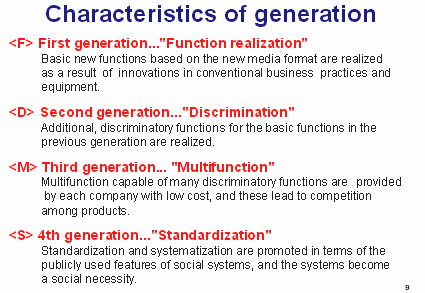Held by the Collaborative Board of TRIZ Promoters and Users in Japan
August 31 - September 2, 2006
| Technology Forecast by the 9-Window Method and the FDMS cycle | |
| Kunio Fukatsu(TOSHIBA Social Automation Systems) | |
| Presented at The Second TRIZ Symposium in Japan Held by the Collaborative Board of TRIZ Promoters and Users in Japan August 31 - September 2, 2006 |
|
| [Posted on Jan. 7, 2007] |
For going back to Japanese pages, press buttons..
Editor's Note (Toru Nakagawa, Jan. 3, 2007)
The paper posted here was originally presented in an oral session at the Second TRIZ Symposium in Japan
held by the Japan TRIZ CB. Please refer to the official documents and reports of the Symposium
posted in the official page of the Japan TRIZ CB. Nakagawa has also posted his 'Personal Report' of the Symposium
for the purpose of introducing the Symposium by reviewing all its presentations.
In the Symposium, the oral presentation was given by projecting Japanese and English slides on different screens in parallel. In the English Edition of the Proceedings, the slides in English are published, while in the Japanese Edition the full paper and the slides in Japanese are published. In this English Home Page, the part of my 'Personal Report'
reviewing this presentation is cited below for the purpose of introduction, and the full set of English slides
are also posted in the PDF format. In the Japanese page
, the full paper in PDF
and the Japanese slides in PDF
are posted.
We wish to express our sincere thanks to the Author for his excellent presentation in the Symposium and for his permission to post it publicly in this Web site.
Introduction & Review of this Presentation (Toru Nakagawa (OGU), Nov. 4, 2006)
Excerpt from Nakagawa's 'Personal Report of The Second TRIZ Symosium in Japan'
(posted on Nov. 8, 2006)
Kunio Fukatsu (TOSHIBA Social Automation Systems) [34] gave an oral presentation on "Technology Forecast by the 9-Window Method and the FDMS Cycle". The Author has been working in designing social automation systems, especially with paper/card handling functions. With historically reviewing such systems, the Author has characterized the four stages of S-curves in the following way and defined the terms of the FDMS Cycle as:

Then, he extended the TRIZ 9-Window representation in a way as shown in the following slide. Here shows (in the rows) the hierarchy of systems in the case of the ATM system and its subsystems, and (in the columns) characteristic stages of the evolution in terms of the FDMS Cycle. In the actual case of ATM systems, shown in this fugure, it was found that the FDMS Cycle of the Subsystem (Passbook printer) has been shifted by one phase of the FDMS Cycle of the System. The Author explains that the 'Function realization' in a subsystem urges the System to proceed to the next step in the FDMS Cycle.
This kind of graphs are useful to think of the next generation of the current syetems, the Author says. -- This is an elegant explanation about the hierarchy of S-curves and the evolutionary relationships between a system and its subsystems.
Paper and Slides in PDF
Slides (in English)
(PDF, 23 slides, 4 slides/page, 382 KB) Click Here.
Slides (in Japanese) (PDF, 23 slides, 4 slides/page, 423 KB) Click Here
.
Full Paper in Japanese (PDF, 6 pages, 227 KB) Click Here
.
Last updated on Jan. 7, 2007. Access point: Editor: nakagawa@utc.osaka-gu.ac.jp